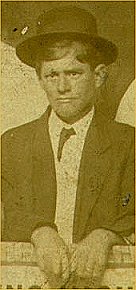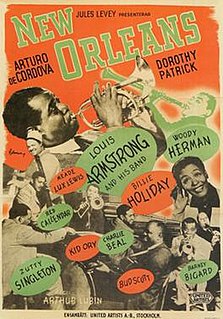
Johnny Bayersdorffer (4 September 1899 – 14 November 1969) was a New Orleans jazz cornetist and bandleader.

New Orleans is a consolidated city-parish located along the Mississippi River in the southeastern region of the U.S. state of Louisiana. With an estimated population of 393,292 in 2017, it is the most populous city in Louisiana. A major port, New Orleans is considered an economic and commercial hub for the broader Gulf Coast region of the United States.
Jazz is a music genre that originated in the African-American communities of New Orleans, United States, in the late 19th and early 20th centuries, and developed from roots in blues and ragtime. Jazz is seen by many as "America's classical music". Since the 1920s Jazz Age, jazz has become recognized as a major form of musical expression. It then emerged in the form of independent traditional and popular musical styles, all linked by the common bonds of African-American and European-American musical parentage with a performance orientation. Jazz is characterized by swing and blue notes, call and response vocals, polyrhythms and improvisation. Jazz has roots in West African cultural and musical expression, and in African-American music traditions including blues and ragtime, as well as European military band music. Intellectuals around the world have hailed jazz as "one of America's original art forms".
A bandleader is the leader of a music group such as a rock or pop group or jazz quartet. The term is most commonly, though not exclusively, used with a group that plays popular music as a small combo or a big band, such as one which plays jazz, blues, rhythm and blues or rock and roll music. Most bandleaders are also performers with their own band, either as singers or as instrumentalists, playing an instrument such as electric guitar, piano, or other instruments.
Bayersdorffer was a popular bandleader at the Spanish Fort resort on Bayou St. John by Lake Pontchartrain. He is best remembered to later generations for his 1920s recordings for Okeh Records. Bayersdorffer also played with Happy Schilling and Tony Parenti's bands.

Bayou St. John is a bayou within the city of New Orleans, Louisiana.

Lake Pontchartrain is a brackish estuary located in southeastern Louisiana in the United States. It covers an area of 630 square miles (1,600 km2) with an average depth of 12 to 14 feet. Some shipping channels are kept deeper through dredging. It is roughly oval in shape, about 40 miles (64 km) from west to east and 24 miles (39 km) from south to north.

Okeh Records is an American record label founded by the Otto Heinemann Phonograph Corporation, a phonograph supplier established in 1916, which branched out into phonograph records in 1918. The name was originally spelled "OkeH", formed from the initials of Otto K. E. Heinemann, but later changed to "OKeh".







